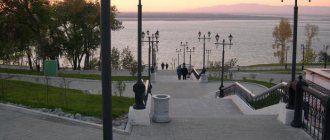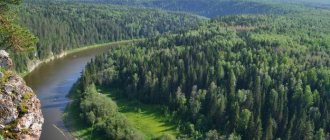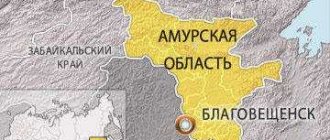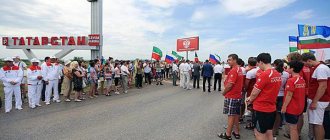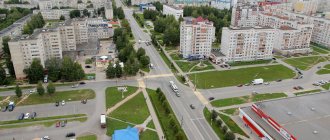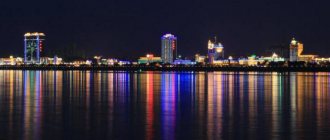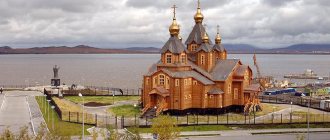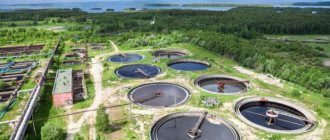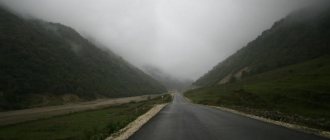In the Far East of the Russian Federation is the city of Khabarovsk. It is the administrative center of the Khabarovsk Territory and the Far Eastern Federal District of the Russian Federation. In the East it occupies a leading position in education, culture and politics. It is a large industrial and economic metropolis. It is located at a distance of about 30 km from the border of the People's Republic of China.
Where exactly is Khabarovsk? What is the city's climate? What is the area of Khabarovsk? Also below are data on the population of the regional capital. It also talks about the economy and describes the regions of Khabarovsk.
General information about the city
Initially, Khabarovsk was located on neutral territory, without borders, between the Russian Federation and China. And only after a general agreement was the disputed land given to the Russian Empire. Khabarovsk was founded in 1858, and in 1880 it was given city status. Since 2002, it has become part of the Far Eastern Federal District.
The city became the capital of the Khabarovsk Territory. It houses the headquarters of the military district, 200 regional federal authorities, as well as the Ministry for the Development of the Far East. He is a member of the Association of Siberian and Far Eastern Cities.
In the center, where Khabarovsk is located, the largest air and railway transport routes intersect. The city is located on the outskirts of the state and in a different time zone. That is why the question arises: “How long is it from Moscow to Khabarovsk?” It is located at a distance of 8 thousand 500 km from the capital of the Russian Federation, if you travel by rail, and about 6 thousand km by plane. Today the transport interchange is well developed. The city has two airports, four railway stations, and a river port.
How federal districts and their centers have changed
The center of the federal district is a settlement in which the plenipotentiary representative of the head of state, his apparatus, and various coordinating bodies are located. In addition, departments of federal ministries and departments may be created in the capitals of federal districts. Decisions on their establishment are made by government agencies themselves.
Federal districts were established on May 13, 2000 by decree of Putin. Initially, seven federal districts were formed with centers in large cities: Central Federal District (center - Moscow), North-Western (St. Petersburg), North Caucasus (Rostov-on-Don), Volga (Nizhny Novgorod), Ural (Ekaterinburg) ), Siberian (Novosibirsk) and Far Eastern (Khabarovsk).
On June 21, 2000, the North Caucasus District was renamed the Southern District, while the center of the district remained in Rostov-on-Don. On January 19, 2010, a separate North Caucasus Federal District with its center in Pyatigorsk, Stavropol Territory, was separated from the Southern District.
On March 21, 2014, in connection with the formation of new subjects of the Federation - the Republic of Crimea and the federal city of Sevastopol - the Crimean Federal District was created with its center in Simferopol. On July 28, 2021, by decree of the head of state, the Crimean District was liquidated, and the constituent entities of the Russian Federation previously included in it were transferred to the Southern Federal District. On November 3, 2021, Buryatia and the Trans-Baikal Territory were withdrawn from the Siberian District and included in the Far Eastern Region.
Currently, there are eight federal districts in Russia. Almost all of their centers are located in the capitals of the constituent entities of the Federation or cities of federal significance. The exception is the North Caucasus Federal District with its capital in Pyatigorsk.
Climate and time zone of Khabarovsk
What is the climate in the city? Where is Khabarovsk? The city is located in the southern Middle Amur Lowland, where two rivers merge: the Ussuri and the Amur. It is washed by the Seas of Japan and Okhotsk. Its relief is varied. The central part is located on gentle hills (hills) above sea level 70-90 m.
Due to its close location to the sea, the climate of Khabarovsk is moderate, with warm but rainy summers and cold winters. In winter, the average temperature is around -20 degrees, and the temperature in mid-July is about +21 degrees. The climate of Khabarovsk is monsoon type, as in winter there is little snow and cold, and in summer it is warm and often rains. In January 2011, weather forecasters recorded the lowest temperature of -41 degrees. In the summer of 2010, the thermometer showed a maximum temperature of +36.7 degrees.
The time zone of Khabarovsk is located in Vladivostok time and is offset by +10 hours Coordinated Universal Time (UTC). The difference with the Russian capital is +7 hours.
Ecology and climate
The climate in Khabarovsk is a bit like Siberia: in winter the temperature drops below –20 °C.
Climate diagram in Khabarovsk
Precipitation is rare throughout the year; the air, despite the close location of the river, always remains dry. But disasters still occur, although they are rare: heavy snowfalls, frosts down to -40 ° C, floods in the warm season.
Precipitation levels in Khabarovsk
In summer the weather remains moderately warm, temperature +20–25 °C. Heat periods also occur, but when the thermometer rises above 35 degrees, this does not last more than two to three weeks. These days, townspeople usually go to the bank of the Amur, where the water warms up to +25 °C.
Despite the presence of large industrial enterprises, the ecology of Khabarovsk does not cause concern: the wind from the river disperses the smog.
Only on windless days can you feel that the air in the city is still polluted, although the level of pollution does not exceed permissible standards.
But soon this problem will be solved: the municipal authorities have adopted a program to improve the environmental situation in the city. To achieve this, all three thermal power plants, which are the main sources of pollution, will be equipped with the latest powerful filters.
Population and area of Khabarovsk
Khabarovsk Territory is the most sparsely populated region of the Russian Federation. This is mainly influenced by the harsh climate, as well as the decline of the economy, which has continued since post-Soviet times. As of 2021, the population in the region is 1 million 333 thousand 294 people, where the population density is 1.69 people per km².
Despite the difficulties, the population of Khabarovsk increased every year. In 2003, the number of residents was 580 thousand 400 people, and according to analytical estimates in 2021, 616 thousand 242 people live in the regional capital. The city ranks second in population among the cities of the Far East.
The population of Khabarovsk and the Khabarovsk Territory is multinational and diverse. As of 2010, the percentage of residents of different nationalities is:
- about 92% are Russian;
- 2.1% - Ukrainians;
- 0.8% - Nanais;
- 0.6% - Koreans, Tatars;
- 0.4% - Belarusians, Evenks;
- 0.3% are Chinese.
The main part (about 65%) of Far Eastern residents are workers and students. Many residents have higher education. Children and teenagers make up 19% of the total population, and pensioners make up 16%.
The administration of the city of Khabarovsk is trying with all its might to improve conditions for large families in the city: medical care is becoming better, providing financial assistance, improving the health of children of low-income families, building playgrounds, landscaping parks, etc.
The area of Khabarovsk is 386 km². The length of the city along the coast is 33 km.
Educational establishments
In the center of the Khabarovsk Territory there are more than four dozen institutions of primary and secondary vocational education. Higher education is represented by more than 30 institutes, universities and branches of universities in the city of Khabarovsk. Among them, the most prestigious are the following:
- Border Institute of the FSB.
- Far Eastern Medical University.
- Humanitarian and Pedagogical University.
- University of the Foreign languages.
- State University.
- Institute of International Relations.
Mayor of the city
The mayor of Khabarovsk since September 2000 is Alexander Nikolaevich Sokolov. Was selected for 4 years. In 1981, he was appointed head of the industrial and transport department of the Zheleznodorozhny district party committee. In 1983 he became secretary of the party committee of the plant. Gorky, and in 1986 he was appointed director.
In Khabarovsk in 1990, the first democratic elections of the city Council of People's Deputies took place. A. N. Sokolov was elected to the post of deputy and chairman of the city council. His ability to rally strong people around him and his great efficiency helped him win the elections. Already in 1993, he was appointed deputy head of the administration for economic issues.
During the second elections in 2004, A. N. Sokolov took the leading place and received 83.84% of the votes. The mayor of Khabarovsk was also elected for a third and fourth term of office and remains in this position to this day.
Administrative division into districts
The city is divided into 4 districts: Central, Northern, Railway and Southern.
The districts are divided into Khabarovsk districts. There are 5 administrative districts in the city:
- Central is one of the old administrative districts, the center of Khabarovsk. Its territory area is 9.5 km². It differs from others in its more developed infrastructure, cleanliness and amenities. The transport system is well developed. There are educational, cultural and shopping centers here. The river station and the central market are located. As of 2021, the number of residents in the area is 96 thousand 155 people.
- Krasnoflotsky is a district with a population of 91 thousand 997 inhabitants.
- As of 2021, 53 thousand 674 citizens live in the Kirovsky district.
- 151 thousand 990 people live in the Zheleznodorozhny district. It is one of the large areas in the eastern part of the city. It was created in 1938 by order of the Supreme Council of the RSFSR. Its territory occupies about 9.6 thousand hectares. There is an airport, a railway station, a military airfield and a bus station here.
- The industrial district is the largest. 222 thousand 426 people live in it. Located in the southern part. The area has two main transport roads that cross the city from north to south.
Real estate in different areas
Khabarovsk has an unusual structure: from the rectangular compact city center, two “sleeves” more than 50 km long stretch to the sides along the Amur. The main street is located perpendicular to the river. On the map, the city looks like a three-ray “skeleton”, to which the rest of the districts adjoin.
The city has five districts comprising four districts. Some of them are popular with local residents, others cause concern about the criminal situation. Which ones to choose when moving to a permanent place of residence?
Criminal areas of the city
The Industrial District is considered the most unreliable in terms of crime. In Soviet times, those who were released early from prison to work in hazardous industries lived here.
Although this “tradition” has now been eliminated, the area is not attractive. There is garbage everywhere, the walls of the houses are shabby, with peeling paint and plaster. There are almost no roads, and those that exist are replete with potholes and puddles that dry up only in extreme heat.
The criminal situation is no better on the outskirts of Khabarovsk, in the so-called Shanghais. They are called slums built without permission from the authorities. It is in such places that migrants who entered the city through illegal means live.
The population here is constantly changing: as soon as they manage to find work and obtain permission for it, the settlers move to more comfortable houses.
The best areas to live in Khabarovsk
Developed infrastructure, comparative cleanliness and amenities belong to the Central District (the one that resembles a rectangle on the map). There are pharmacies, shops, cafes, and various cultural sites at every step. There are no problems with transport, it always (or almost always) runs on schedule, and it is possible to take the desired minibus or bus.
Although there is still a problem with transport. We are talking about the winter period, when due to significant slopes between the upper and lower streets, the movement of vehicles is difficult, and traffic jams form at intersections and rises.
The Northern District includes the Kirovsky and Krasnoflotsky districts. They stretch along the river and have a cleaner ecological environment. There are few industrial zones here, which means there is less pollution.
The districts of the Southern District are Industrial and Zheleznodorozhny. Their very name suggests that the environmental situation here leaves much to be desired. Externally, both areas differ little: typical “sleeping areas”, with traffic congestion due to diesel locomotives and trucks.
Industrial enterprises and economics
The factories of Khabarovsk make up the bulk of the industrial city. There are 86 main industry enterprises. Main activities:
- processing production;
- distribution and production of water, electricity and gas;
- communications and transport;
- mechanical engineering;
- metal processing;
- wood processing and fuel industry;
- construction;
- provision of catering services and trade;
- Developed activities in the real estate sector.
Since the city needs the development of modern infrastructure and the construction of housing complexes, the city has a mechanism for attracting investment on a long-term basis. In 2008, about 46 million rubles of investment were attracted for construction.
There are about 28 municipal enterprises operating here, operating in 7 sectors of the economy. They constitute the economic sector of the administrative center. The amount of their assets is equal to 13.1 billion rubles.
The Khabarovsk city administration has developed a strategic development plan until 2021. 60 targeted programs have been prepared, most of which are aimed at economic and social development. To implement it you need:
- creating good, safe conditions for citizens;
- creation of a scientific and technical center in the region;
- formation of trade and transport logistics in the region;
- improving the work of the administrative and political center of the Russian Federation in the Far East.
Labor market in Khabarovsk
The city today is home to more than 600,000 people, and the population continues to grow. The following factors contribute to this:
- Normal standard of living.
- Increasing flow of immigrants.
- Availability of sufficient housing, schools, kindergartens, and medical institutions.
- Low unemployment: in December 2021, about 1,500 unemployed people were registered in Khabarovsk.
- Availability of jobs. Today there are more than 10,000 vacancies.
On a note . The city has an acute shortage of engineers and highly skilled workers. Employers are willing to pay specialists high salaries, the amount of which is much higher than the average salary.
Among the most in-demand specialties in 2021:
In-demand professions in Khabarovsk
- Finishers.
- Superintendents.
- Tower crane operators.
- Masons.
- Teachers.
- Doctors.
- Nurses.
- Nurses.
- Sellers.
- Accountants.
- Gas-electric welders.
- Bulldozer drivers.
- Drivers of heavy vehicles.
- Preschool teachers.
Salaries in Khabarovsk are the highest in the region: here on average they receive 36,000 rubles per month. The price of the minimum basket does not exceed 12,000.
You can find out about the average salary in Khabarovsk on our website.
Railway transport
Railway construction is actively developing in the Far East. The history of the city station begins with the reign of the great Romanovs. According to historical data, it was they who laid the first stone where the largest railway routes now pass, carrying huge cargo and a large number of passengers.
In 1891, the Ussuri Railway was built, and already in 1897 a road was built between Khabarovsk and Vladivostok. The construction of the Amur section of the Trans-Siberian Railway turned the city into a major transport hub. This is how the Khabarovsk-2 railway station appeared. Subsequently, a large Zheleznodorozhny district was built.
Khabarovsk-1 Railway Station is a passenger railway station that impresses all visitors with its original architecture. It was opened in 1905. The station is located in the center of the city itself. In its one hundred and tenth year, the station was completely renovated using funds from the city budget, with the participation of local patrons. From the former station, only the famous monument to E.P. Khabarov, which stands on the station square, remained untouched.
City transport
Khabarovsk is of great international and regional importance in transport communications from the north to the west of the country. The city connects the federal points of the Ussuri, Amur, Khabarovsk-Komsomolsk-on-Amur and Vostok highways. Back in 1893, a bus station was built that could support a passenger flow of five hundred passengers per hour. International buses connect the central and eastern regions.
With the help of the Amur River Shipping Company, passenger and cargo transportation is carried out along the Amur River. The vessels carry out sea transportation (both cargo and passengers) to remote areas of the Far Eastern Territory. The city has a cargo river port, a river station for passengers, and a Khabarovsk fleet repair and maintenance base. Passengers travel down the river using the Meteora motor ships, and up the Tunguska River there is a series of high-speed ships called Zarya. In Soviet times, cruise ships sailed along the Amur River. Currently, such ships have already been canceled, however, it is quite possible that cruise routes will return in the future.
Air transport in Khabarovsk is well developed. Air transportation is carried out through the Small and Large airports, which are located ten kilometers from the center of Khabarovsk. In addition, the city has an aircraft repair base. Air traffic from Japan to Europe passes through the air traffic control zone. The Central and Dynamo military airfields are located here.
Trams, trolleybuses, minibuses and buses run around the city. The length of intracity transport lines is about 500 kilometers. Due to the complex networks of underground rivers and mountainous terrain, no metro was built in the city. Such construction would threaten Khabarovsk, which, with any flaw, could go underground.
Art and culture of the city
Khabarovsk is not only a large industrial center, but also a city of culture in the Far East. It houses the following city museums:
- Regional Museum. It was founded back in 1894 with the help of the Amur Department of the Russian Geographical Society. A stone turtle weighing 6,400 kg was installed in front of the building. In 2005, the museum opened a new exhibition of Amur fish.
- Museum of Archeology named after. A. P. Okladnikova.
- Museum of the History of the City. It was opened in 2004. It contains museum exhibits from Khabarovsk from the pre-revolutionary period to modern times.
- Art Museum.
- Military History Museum of the Far Eastern District. Started working in 1983. It contains samples of military equipment from different times.
- Amur Bridge Museum.
- Art Gallery named after. Fedotova.
- Museum of the history of Khabarovsk-1 station.
Since 1978, the central library named after. P. Komarova, as well as its ten branches. A children's library was also built. A. Gaidar and the scientific library of the Academy of Science and Law.
Khabarovsk
History of Khabarovsk
Until the mid-19th century, the lands on which Khabarovsk now stands were considered a neutral zone between Russia and the Great Qing Empire. Before the expedition of Gennady Ivanovich Nevelsky, everyone was convinced that navigation on the Amur was impossible. There was an opinion that this river does not flow into the sea, but is lost in the sands.
Khabarovsk in the 1890s
View of the Khabarovsk cliff in the 1900s
Plan of Khabarovsk, 1911
In 1858, representatives of the two countries signed an agreement. The left bank of the Amur became Russian, and the right bank of the river up to the mouth of the Ussuri went to China. In the same year, the Governor-General of Eastern Siberia, Count N.N. Muravyov, ordered the deployment of the 13th line battalion on the Amur. The soldiers, led by commander Yakov Vasilyevich Dyachenko, became the first builders of the city. They built the village of Khabarovo or, as they said then, Khabarovka, in which military personnel, recruited settlers and penal soldiers began to live.
The first urban plan for Khabarovka appeared in 1864. Three Sikhote-Alin spurs received the name “mountains” - Military, Middle and Artillery. Streets and neighborhoods arose on them, as well as soldier barracks, food warehouses, residential buildings and merchant shops.
A little later, civilian migrants from different parts of Siberia began to come to Khabarovka. They obtained furs and fished. In 1873, a primary school was opened in the village, and the very first market appeared here in 1877. According to the concluded agreement, goods made by workers of Chinese and English factories were sold duty-free in Khabarovka.
In 1880, the growing settlement became a city. After 13 years it was renamed Khabarovsk. The new city grew and quickly became a major cultural center. It published a newspaper, had a branch of the Russian Geographical Society, and even had its own museum. At the end of the 19th century, the railway from Khabarovsk reached Vladivostok. In 1916, a bridge was built across the Amur, and it became possible to travel by rail to Eastern Siberia.
Khabarovsk at the beginning of the 20th century
Military parade in Khabarovsk. 1936
After the fighting of the civil war, Soviet rule was established in the region. The city's population continued to increase, and in 1926 it was already 52 thousand people. With industrialization, new enterprises grew here, an airfield appeared, and several universities were opened.
After the end of the Great Patriotic War and the war with Japan, the city actively developed infrastructure. In 1956, the first trams began to run along Khabarovsk streets, and in 1975, trolleybuses.
Khabarovsk in the 80sInteresting Facts
- When Erofey Khabarov visited the Far East, he sent a letter to Moscow, where he wrote that the land of Dauria would be more profitable than Lena.
- In 1890, during a trip to Sakhalin, the writer Anton Pavlovich Chekhov stayed in the city. A year later, the future Russian Emperor Nicholas II visited here, who at that time was traveling around the world. In 1913, the famous Norwegian traveler Fridtjof Nansen made a stop in Khabarovsk.
- Several times Khabarovsk took part in a competition among federal subjects of the Russian Federation and received first place as the most comfortable city in the country.
- Khabarovsk is located next to China, so the city receives Chinese TV channels and can receive networks of cellular operators from China.
Geographical location and climate
Bridge over the Amur
The distance from the Russian capital to Khabarovsk by air is 6,100 km, and by rail – 8,533 km. The nearest settlement in China, the village of Fuyuan, is only 65 km from Khabarovsk.
The city was built on the lands of the Middle Amur Lowland, not far from the mouth of the Ussuri River. It stretches along the elevated bank of the Amur River and the Amur Channel for 33 km and has an area of 383 km².
Khabarovsk is located in a zone of temperate monsoon climate. The entire Far East is dominated by warm, humid summers and snowy, frosty winters. The average temperature in January is -20 °C, and in July +21.3 °C. The coldest winter here was in 2011, when the thermometer dropped to -41.1 °C. A year earlier, an absolute summer maximum of +36.7 °C was recorded in Khabarovsk.
In the Far Eastern city, the weather is sunny about three hundred days a year. On similar days, it is three times larger than Moscow and St. Petersburg. It is especially sunny in the region from late autumn to early spring, when the winter Siberian anticyclone dominates here. During the year, 684 mm of precipitation falls over the city. The rainiest months are July and August, while winter, on the contrary, is dry.
Khabarovsk in winter
Green areas and zoo
If your visit to Khabarovsk falls between May and October, it is worth taking a look at the local arboretum, which is located on Volochaevskaya Street, 71, almost in the city center. The green zone appeared here in 1896. It began with an experimental laboratory with a nursery and a forestry field. Time passed, and the territory grew into a large botanical garden with an area of 12 hectares.
Khabarovsk Arboretum
The Khabarovsk Arboretum is a popular natural attraction and a great place for walking. It is home to 386 species of plants brought from different parts of the planet. In the alleys there was a place for Amur wild grapes, Ussuri pear, Amur velvet, Manchurian walnut and Chinese lemongrass. You can get to the arboretum by trams No. 1, 2 and 6.
An excellent place to relax is the Dynamo city park, located north of Lenin Square, on Karl Marx Street, 62. The park area covers 31 hectares. It is very popular among Khabarovsk residents and tourists on summer weekends. Here you can have a nice walk and have a good time in one of the summer cafes. In the center of the green area there are three artificial ponds. One of them has a pedal boat rental station. In the evening, on the upper pond you can see a show of light and music fountains.
Dynamo Park
Arkady Gaidar Park
Parents with children prefer to come to the small children's park named after Arkady Gaidar, which is located opposite Dynamo Park, on Lev Tolstoy Street, 2. It has everything you need for a fun holiday - many attractions, playgrounds and a children's ice cream parlor.
Zoo in Khabarovsk
In the Northern district of the city lies the territory of the Khabarovsk Zoo, which bears the name of Vsevolod Sysoev. Khabarovsk residents call it the Priamursky Zoo. From the city bus station you can get here by regular bus No. 114. The zoo was created in 2002. It contains red, gray, polar and Canadian wolves, Himalayan bears, Amur tigers, Siberian chipmunks, squirrels, wild boars, arctic foxes, foxes, lynxes, reindeer and sika deer - almost 30 species of animals. Among the birds that live in the zoo are Far Eastern storks, Steller's and white-tailed eagles, crested honey buzzards, kestrels, golden eagles, long-tailed owls, several species of owls, pheasants and mallards.
It is noteworthy that all animals and birds are kept in spacious enclosures, and none of them were specifically removed from the natural environment. Animals came to the zoo in different ways. Most of them are wounded animals or young animals that died during the hunt.
From April to September the zoo is open from 10.00 to 19.00, from October to March - from 10.00 to 18.00. You can see the animals any day except Monday. Children under 5 years old are allowed into the zoo free of charge.
Cathedral
The main temple of the local diocese is the Transfiguration Cathedral. It stands on the river bank, in the city center. Its golden domes sparkle in the sun and are visible from afar. The cathedral rises 96 m above the steep bank and is considered the third Russian temple in height, second only to the Cathedral of Christ the Savior and St. Isaac's Cathedral.
The Khabarovsk Cathedral was built in 2001-2004 using charitable contributions from Khabarovsk residents and enterprises. The five-domed church can accommodate up to 3,000 believers at a time. The religious building attracts not only those who come to pray, but also tourists. People visit the Transfiguration Cathedral to listen to beautiful church singing and admire the rich interior decoration. The Cathedral is one of the most picturesque newly built buildings in the Far Eastern city. There are benches around it where you can relax and admire the surroundings.
Spaso-Preobrazhensky Cathedral of Khabarovsk
Museums
The oldest regional museum in Khabarovsk named after Nikolai Ivanovich Grodekov is called by the residents themselves the “Grodekovsky Museum”. It was founded in 1894 and today is housed in a building that was built in 1900 on Shevchenko Street, 11. By visiting here, you can learn about the distant past of the Amur region, the culture and traditions of indigenous peoples, the history of the development of the Amur region by Russia and the features of the Far Eastern nature.
The museum halls contain geographical maps, geological samples from all over the Far East, ethnographic exhibits, coins, medals, paper banknotes and ancient photographs. The gallery of the third building displays a huge skeleton of a fin whale. On the approaches to the building, artillery pieces of the 19th century are visible, and in front of the entrance there is a stone tombstone of the medieval commander Esukui, made in the form of a large turtle.
Khabarovsk Museum of Local Lore named after. N.I. Grodekova
For guests, the doors of the regional museum in Khabarovsk are open from 10.00 to 18.00, on all days except Monday. On Thursdays the museum welcomes guests from 13.00 to 21.00. Please note that the ticket office closes one hour earlier.
From Tuesday to Saturday there is a tourist information center at the Grodek Museum. This is a place where you can get advice about public transport, Khabarovsk museums and hotels. The tourist information center is open from 10.00 to 18.00.
Okladnikov Museum of Archeology
On Turgenev Street, 86, in a beautiful two-story mansion, there is the Okladnikov Museum of Archeology, which has the status of a branch of the regional museum. In front of the entrance to the building there are concrete copies of stone petroglyphs found near the Nanai village of Sikachi-Alyan. Inside the museum there are spectacular exhibitions that demonstrate what an archaeological site, a prehistoric cave, a taiga camp and a cave labyrinth look like.
In 2004, a separate museum of the history of the city was created in Khabarovsk. It is located in the Palace of Culture, on the street. Lenina, 85, not far from the city administration building. Museum exhibitions introduce visitors to the history of Khabarovsk from its founding, as well as the events that took place in the Far East during the Civil and Great Patriotic Wars. The museum doors are open every day except Monday, from 10.00 to 18.00.
Museum of the History of the Far Eastern Military District
Of great interest are the collections of the military museum of the Far Eastern Military District, which is located on Shevchenko Street, 20. Museum exhibits tell about the history of the Soviet Army in the Far East, and in the open area you can see samples of weapons and military equipment from different years. The military museum is open on weekends. Children are allowed here for free.
In the Krasnoflotsky district of Khabarovsk, there is an open-air museum of the Amur Bridge, created on the initiative of the Far Eastern Railway. Museum visitors can take a walk along the old bridge structure, built before the revolution, and also see rare steam locomotives and carriages. Other museum exhibits are housed in a wooden building that reproduces the first building of the Khabarovsk railway station.
Art lovers should pay attention to the Far Eastern Art Museum. It is located on Shevchenko Street, 7, and presents rich collections of Russian and Western European art, the art of the ancient world, the peoples of the East and the indigenous peoples of the North. The museum was created in 1934 on the basis of proceeds from the Tretyakov Gallery, the Historical Museum and the Pushkin Museum of Fine Arts. The Khabarovsk Art Museum is open on all days except Monday, from 10.00 to 18.00.
Since 2005, the “Fish of the Amur” aquarium museum has been operating in the city. You can see 125 species of Amur fish there. The aquarium museum is located on Amursky Boulevard, 13, and is open to visitors from Wednesday to Sunday from 11.00 to 17.00.
Panorama of Khabarovsk
What to see in the vicinity of Khabarovsk
Many travelers do not limit themselves only to city attractions, but take interesting routes in the vicinity of Khabarovsk. It should be borne in mind that in spring and summer, everyone who wants to travel outside the city needs to protect themselves from the encephalitis tick. To do this, they do a preliminary vaccination, and use repellents during the trip.
Sikhote-Alin Nature Reserve
Excursions to the Utes wild animal rehabilitation center, which is located in the western foothills of Sikhote-Alin, a two-hour drive from the city, are popular among tourists. The rehabilitation center is maintained by a non-profit organization located in the village of Kutuzovka. Here they treat tigers, bears, lynxes, deer, wild boars, roe deer, raccoons and foxes - all taiga animals that find it difficult to survive without human help. Visitors are offered excursions along an ecological trail equipped with observation platforms.
Trips to the Nanai village of Sikachi-Alyan, located on the banks of the Amur, are very popular. They get there by regular bus No. 205, which runs from the Khabarovsk bus station. Since 2005, a branch of the Grodekovsky Museum has been organized in the village, where you can get acquainted with unique petroglyphs, as well as the customs and culture of the Nanai people.
Petroglyphs of Sikachi-Alyan
The museum exhibits stone tools from the 11th century BC, a model of a Neolithic settlement, a Nanai bride’s costume, wooden utensils, clothes made of fish skin and equipment for hunting and fishing. The museum in Sikachi-Alyan is located on Oktyabrskaya Street, 1A. It is open every day except Monday, from 10.00 to 18.00.
Bolshekhehtsirsky Reserve
From Khabarovsk, tourists go to the Bolshekhekhekhtsirsky nature reserve, which is located 20 km from the city, in the spurs of the Bolshoi Khekhtsir ridge. A trip to the reserve allows you to get acquainted with many endemic plants and animals, as well as visit beautiful taiga landscapes. The protected area was established in 1963. Today it covers 45 thousand hectares of natural land, 12 thousand of which are under special protection. The thorny plants and vines growing here give the local forests the appearance of an impenetrable tropical jungle. Populations of rare species of animals – the Amur tiger and the Himalayan bear – have been preserved within the reserve. On the territory you can also find wapiti, musk deer, harza, lynx, weasel and sable.
Regular bus No. 107 runs from Khabarovsk to the reserve. It leaves once every 30 minutes and takes one and a half hours to the village of Bychikha, where the administration of the nature conservation area is located at house 8 on Yubileinaya Street.
Transport
Trolleybus in Khabarovsk
There are trams, trolleybuses, buses and minibuses running around Khabarovsk. The city is quite large, so the length of public transport routes exceeds 500 km. There are no plans to build a metro here due to the large number of underground rivers and hilly terrain.
There is a passenger river port in Khabarovsk. It is located at the beginning of Ussuriysky Boulevard, on Shevchenko Street, 1. Navigation lasts several months, from May to October. Previously, there was a cruise service on the river, but now there are no such ships. Down the Amur River, to Nikolaevsk-on-Amur, Komsomolsk-on-Amur and Amursk, passengers are transported on Meteors. Up the Tunguska River - on the Zarya motor ships. The Polesie motor ships go to the Chinese village of Fuyuan, and you can get to the opposite, left bank of the Amur on the Moskva and Moskvich motor ships.
Souvenirs
When leaving Khabarovsk, tourists take away various souvenirs as souvenirs of the Far Eastern city - magnets, keychains, plates and notebooks with views of Khabarovsk. Very popular taiga souvenirs are pine nuts, lingonberries, cranberries, ferns, lemongrass, eleutherococcus and other medicinal plants growing in the Far East. Many people like crafts made from deer antlers, leather, wood, stones and fangs of wild animals, as well as copies of petroglyphs from the Nanai village of Sikachi-Alyan.
TSUM Khabarovsk
Souvenir products are sold in the Central Department Store, large shopping centers, a bookstore near Lenin Square, in the local history museum and specialized souvenir shops. Excellent purchases can be made in the “Secrets of Craft” store and the Art Salon, which are located on Muravyov-Amursky Street.
Khabarovsk is close to Korea and they sell a lot of Korean products here. Most tourists try to buy Far Eastern delicacies in the city - red fish and caviar. Fresh and smoked seafood can be found in any supermarket in the city. Maxim brand coffee, Ussuri balsams and confectionery products from the local Sputnik factory are in great demand.
Where to stay
To accommodate tourists in Khabarovsk, there are about 40 hotels offering different levels of service. These are motels, mini-hotels, apartments, guest houses and large hotel complexes. Those who want to rent inexpensive accommodation should pay attention to budget hostels. Accommodation in them costs about 500-800 rubles per night.
Assumption Cathedral on Komsomolskaya SquareStele "City of Military Glory"
Some travelers prefer to rent an apartment in the desired area of Khabarovsk from private owners. There are plenty of offers for daily apartment rentals at any time of the year. Many Khabarovsk residents rent out rooms, hotels, one- to three-room apartments and housing that has more than six rooms. The rental price starts from 1,700 rubles.
Booking.com
How to get there
There are four airfields located around Khabarovsk. Tourists are received by two of them: “Khabarovsk-Novy” and “Khabarovsk-MVL”. Khabarovsk-Novy International Airport is one of the largest in the Far East. It serves flights from the cities of the Khabarovsk Territory, from the Far East, from other places in the country and from abroad. You can fly to Khabarovsk both with and without transfers. Every day, planes fly from Moscow Sheremetyevo Airport to Khabarovsk at 21.30. The flight lasts 8 hours and ends in Khabarovsk at 12.30 local time. Flights with one transfer take about 12 hours, and with two – 17 hours.
Khabarovsk-Novy Airport
Khabarovsk-Novy Airport is 10 km away from the city. Travelers get to Khabarovsk by bus No. 35, trolleybus No. 1 or taxi. By car the journey takes 10-15 minutes, and by public transport – 40-50 minutes.
Khabarovsk-MVL Airport serves local airlines. They are used when you need to fly to remote places where land or river transport does not go. This airport is located 1 km closer to the city than Khabarovsk-Novy. They are separated by one public transport stop.
Khabarovsk railway station is located on Leningradskaya street, 58. All trains that run along the Trans-Siberian Railway stop at the Khabarovsk-1 station. Every day one train passes through the city to the city of Nakhodka and 4-5 trains going to Vladivostok. The road to Khabarovsk from Moscow takes 5.5-6 days, from Irkutsk – 2.5 days, and from Chita – 1.5 days.
People come to Khabarovsk by intercity buses from the cities of the Jewish Autonomous Region and Primorye: Birobidzhan, Komsomolsk-on-Amur, Amursk, Sovetskaya Gavan, Bikin, Vyazemsky, Vladivostok, Lesozavodsk, Ussuriysk, Dalnegorsk and Arsenyev. Khabarovsk bus station is located on Voronezhskaya street, 19.
Calendar of low prices for air tickets to Khabarovsk
Monuments and squares
There are a lot of squares and monuments in the city. The main square of Khabarovsk is Lenin. It hosts all the city's parades and celebrates outstanding local holidays. She is recognized as the most beautiful in the city. The central square of Khabarovsk is Slava Square. It was opened in 1975. There is a monument to the heroes of the Great Patriotic War on it. Komsomolskaya Square is the oldest in the city. In 1923 it was renamed Red Square.
In 2012, the city was awarded the honorary title of the Russian Federation “City of Military Glory”. Stella was erected in honor of this title. Its opening took place in 2015, that is, on the seventieth anniversary of the end of the Second World War. At the foot of the monument, the city administration plans to open a city museum dedicated to the same topic in the near future.
At the Lenin Stadium, the “Black Tulip” monument was erected in honor of the soldiers who died in the Afghan War. The author of the monument was the famous sculptor Yu. Kukuev. The “Black Tulip” attracts a lot of attention from tourists, although what can I say - local residents involuntarily look back at the monument when accidentally passing by. Many townspeople visit him to honor the memory of their relatives or friends.
Near the stadium there is a monument to the Young Defenders of the City. The monument was built in 2004 in honor of those killed during the 1921 Civil War.
A monument to Captain Y. Dyachenko was erected on a granite platform. It was built solely with donations from townspeople. Next to the monument there is a street named after this man.
Famous Landmarks
More than a hundred years ago, the Amur Bridge was built - this engineering miracle is the largest bridge in all of Russia. There is rail and two-way road traffic here. Connects the banks of the Amur River. This is one of the unique places in the city.
Modern Khabarovsk has many beautiful places that both tourists and city residents love to visit. In 1983, amazingly beautiful city ponds were built. They consist of three ponds, which are created in the form of a cascade and are separated by a small dam. Around them lie green and shady alleys. In 2011, light illumination and fountain equipment were installed on the ponds. Nowadays, many citizens gather here in the evenings to enjoy the light show, and during the day, those who enjoy the pleasant murmur of the fountains stroll nearby.
Also the city embankment named after. Nevelskogo is a tourist attraction. The Amur cliff is the pride of the townspeople themselves. Local residents often come to this beautiful place to relax with their families, lovers make appointments here, and older townspeople like to stroll. The Amur cliff is considered a particularly romantic place for lovers and newlyweds; during the “wedding season” newlyweds are photographed here every now and then, and people believe that visiting this place on their wedding day is a sign of strong family happiness. The Amur cliff is located in the historical part of Khabarovsk.
On Komsomolskaya Square there is another pride of the Far East - the Grado-Khabarovsk Cathedral of the Assumption of the Mother of God. Every traveler visits it to look at the extraordinary beauty of the cathedral's architecture. The height of the temple is 50 m. It is the first one that is clearly visible immediately upon entering the city. The building took ten years to build, and in 1886 the first service was held there.
Muravyov-Amursky Street is another famous landmark of the city, both among locals and tourists not only in Russia, but also from other countries. It is here that those very old houses have been preserved, which stand out sharply against the background of the modern city, reminiscent of the past. On the street there are many cozy restaurants and cafes that offer both coffee and cakes and full meals at affordable prices, and there is also the best cinema in the city. The shops sell Far Eastern souvenirs for tourists.
